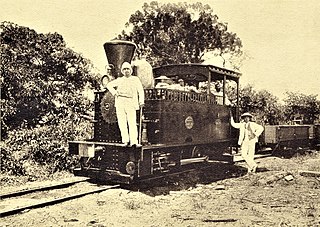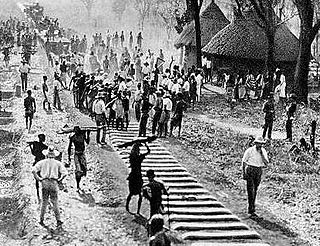Related Research Articles

The Congo River, formerly also known as the Zaire River, is the second longest river in Africa, shorter only than the Nile, as well as the second largest river in the world by discharge volume, following only the Amazon. It is also the world's deepest recorded river, with measured depths in excess of 220 m (720 ft). The Congo-Lualaba-Chambeshi River system has an overall length of 4,700 km (2,920 mi), which makes it the world's ninth-longest river. The Chambeshi is a tributary of the Lualaba River, and Lualaba is the name of the Congo River upstream of Boyoma Falls, extending for 1,800 km (1,120 mi).

Brazzaville is the capital and largest city of the Republic of the Congo. Constituting the financial and administrative centre of the country, it is located on the north side of the Congo River, opposite Kinshasa, the capital city of the Democratic Republic of the Congo.

The Lualaba River flows entirely within the eastern Democratic Republic of the Congo. It is the greatest river source (headstream) of the Congo River by volume of water. The Lualaba is 1,800 kilometres (1,100 mi) long. Its headwaters are in the country's far southeastern corner near Musofi and Lubumbashi in Katanga Province, next to Zambia. The Chambeshi River is the longest river source (headstream) of the Congo.

The Luapula River is a section of Africa's second-longest river, the Congo. It is a transnational river forming for nearly all its length part of the border between Zambia and the DR Congo. It joins Lake Bangweulu to Lake Mweru and gives its name to the Luapula Province of Zambia.

Kananga, formerly known as Luluabourg or Luluaburg, is the capital city of the Kasai-Central Province in the Democratic Republic of the Congo and was the capital of the former Kasaï-Occidental Province. It is the fourth most populous urban area in the country, with an estimated population of 1,524,000 in 2021.

Kalemie, formerly Albertville or Albertstad, is a town on the western shore of Lake Tanganyika in the Democratic Republic of the Congo. The town is next to the outflow of the Lukuga River from Lake Tanganyika to the Lualaba River.

Kindu is a city in the Democratic Republic of Congo, the capital of Maniema province. It has a population of about 200,000 and is situated on the Lualaba River at an altitude of about 500 metres, and is about 400 km west of Bukavu.

Kamina is the capital city of Haut-Lomami Province in the Democratic Republic of the Congo.

The Matadi Bridge, also known as the OEBK Bridge for Organisation pour l’équipement de Banana-Kinshasa, and formerly known as Pont Maréchal in French, is a suspension bridge across the Congo River at Matadi, Democratic Republic of the Congo. It was completed in 1983 by a consortium of Japanese companies. With a main span of 520 metres (1,710 ft), it was the longest suspension bridge in Africa from its inauguration until the 2018 opening of the Maputo–Katembe bridge. The bridge crosses the Congo River at its narrowest point, just downstream from the port of Matadi. It is in fact the only road and rail crossing of the Congo River proper, the only other existing crossing being the Kongolo Bridge in Katanga which spans the Lualaba River, a tributary of the Congo.

Rail transport is provided in the Democratic Republic of the Congo by the Société Nationale des Chemins de Fer du Congo (SNCC), the Société commerciale des transports et des ports (SCTP) (previously Office National des Transports until 2011), and the Office des Chemins de fer des Ueles (CFU).
Kongolo Bridge is a cantilever rail and road bridge that crosses the Lualaba River. It was constructed by the Belgians in 1939, and was reconstructed in 1968 under the Mobutu regime by the German engineer Erich F. Weigl. It is located near the town of Kongolo.
Kasongo, also known as Piani Kasongo, is a town and Territory, located in Maniema Province of the eastern Democratic Republic of the Congo.

Manono is a town and territory in Tanganyika Province, Democratic Republic of the Congo.
Bena Kamba is a community on the Lomami River in Maniema province of the Democratic Republic of the Congo.
The Battle of Kabalo was a battle fought at Kabalo by United Nations peacekeeping forces and Baluba militias from 7 April to 11 April 1961 against mercenaries and the gendarmerie of the State of Katanga, a secessionist state rebelling against the Republic of the Congo in central Africa. The Katangese forces attacked the town as part of a larger offensive meant to restore their authority in northern Katanga which was challenged by the Baluba. A United Nations Operation in the Congo peacekeeping contingent garrisoning Kabalo, acting under the authority of their mandate to prevent civil war in the country, resisted the initial attack and arrested 30 mercenaries in Katanga's employ. Armed Baluba repelled a Katangese ferry carrying troops as well as an armoured train. The next day the ferry returned but was sunk by UN forces. Fighting continued over the next few days between the Baluba and Katangese until the latter withdrew. The battle led to a deterioration of relations between the Katangese government and the United Nations Operation in the Congo.

The Compagnie du chemin de fer du Congo supérieur aux Grands Lacs africains was a Belgian railway company established in 1902 in the Congo Free State, later the Belgian Congo, now the Democratic Republic of the Congo. It provided service in the eastern part of the colony south of Stanleyville (Kisangani) to serve the settlers and mining operations in Katanga. It operated a combination of river steamer service along the Lualaba River and railway links where the river was not navigable, including a link to Lake Tanganyika. In 1960 it became the Société congolaise des chemins de fer des Grands Lacs.

The Société des Chemins de Fer Vicinaux du Congo, known as CVC or Vicicongo, was a railway company that operated the narrow gauge Vicicongo line and provided trucking services in the northeast Belgian Congo, and then in the Democratic Republic of the Congo between 1924 and 1974. It provided transport for agricultural goods produced in the northeast that were shipped on the Congo River to Léopoldville (Kinshasa). After independence in 1960 there were civil disturbances and the railway was poorly maintained. The company was taken over by the state in 1974. Later there were further disturbances in which the stations were destroyed and the rolling stock used as a source of metal. The track is decrepit and no longer usable.

The Compagnie de Chemin de fer du Katanga (CFK) was a railway company in the Congo Free State and Belgian Congo between 1902 and 1952. It held the railway concession that linked the port of Bukama on the navigable section of the Lualaba River through the mining region and the town of Elisabethville (Lubumbashi) to Sakania, where it connected with the Rhodesian railway network. Operations were subcontracted to the Compagnie du chemin de fer du bas-Congo au Katanga (BCK).
Odon Jadot was a Belgian railway engineer and administrator. He was responsible for building more than 1,650 kilometres (1,030 mi) of railroad in the Belgian Congo. The lines helped carry copper mined in the Katanga Province to the sea via the ports of Matadi in the Congo, Dilolo in Angola and Beira in Mozambique. They also supported troop movements during World War I (1914–1918) and World War II (1939–1045).

Gaston Crauwels (1923—1962) and Louis Crauwels (1927—1962) were Belgian missionaries of the Congregation of the Holy Spirit (Spiritans) who were killed together with seventeen other Belgian Spiritans and one Dutch brother by radical African nationalist elements of the national army Armée Nationale Congolaise on new year's day 1962, during the Kongolo Massacre. In 2019, the Diocese of Kongolo started the process of beatification of the twenty missionaries, including the Crauwels brothers.
References
- ↑ World Gazetteer: Congo (Dem. Rep.): largest cities and towns and statistics of their population [ dead link ] Mars 2011
- ↑ "ARRÊTÉ DÉPARTEMENTAL 79/BCE/TPAT/60/004/79 portant fixation des listes des routes constituant le réseau des routes nationales et régionales dans la République du Zaïre" (PDF) (PDF) (in French). 28 February 1979. Retrieved 22 November 2021.
- ↑ "RD.Congo. Beatification of twenty martyr missionaries on track". 2019-08-01. Retrieved 2022-05-18.